First Air
Securing the danger zone
Assessment of the condition of the injured
Call for help
Providing first aid
Securing the danger zone
Distance Between the Warning Sign and the Danger Zone
Behavior at the Scene of a Traffic Accident:
When providing first aid, be careful not to put yourself in danger. First ensure safety, then begin giving assistance.
Before exiting your vehicle, put on your reflective vest.
Warn other road users of the danger zone using a reflective triangle, placed at a safe distance from the hazard (see the sketch above).
Inspect the interior of the vehicle.
Make contact with the injured and, if possible, perform an on-site assessment.
Identify anyone in need of immediate attention.
If necessary, carefully remove the injured from the vehicle.
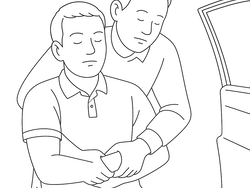
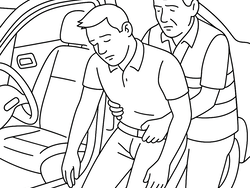
Extraction from the vehicle using an underarm grip:
Check whether the injured person is conscious.
Turn off the car engine without removing the key from the ignition.
Before removing the injured person from the vehicle, check whether their legs are trapped and whether the seatbelt is unfastened.
Hold the injured person under the armpits and turn them toward you.
Pull the injured person out of the vehicle so that they “sit” on your thigh.
Move them out of the danger zone.
Assessment of the condition of the injured
Consciousness check.
It should be checked if the injured person responds to speech, shoulder shaking or mild pain.
The presence of other trauma is also checked.
Call for help
112
You can also get the attention of other people, if there are any around, who could help in this situation. They can call 112, bring a first aid kit and give you other assistance if needed.
Providing first aid
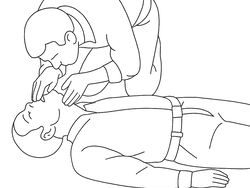
Clear the airway and check breathing
- Tilt the head back towards the back of the head and lift the lower jaw;
- Check by sight, hearing and touch that the chest/abdomen rises and falls as in normal breathing and that you can feel the casualty's breath.
- The breath check should last no more than 10 seconds
- Проверката на дишането трябва да продължи не повече от 10 секунди.
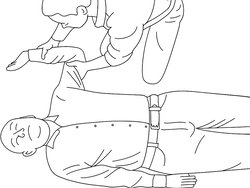
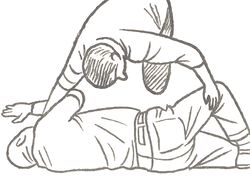
Immediate action in case of unconsciousness
In case the casualty has normal breathing
- Place the casualty in a stable side position
- Call 112 (if you have not already done so)
- Check breathing continuously
Stable side position:
- Kneel on the side of the casualty;
- Place the victim's arm near you with the elbow bent at 90 degrees angle to the victim's body, palm facing up;
- Place the casualty's other arm in front of his chest and bring the top of the palm tightly against his cheek closest to you;
- With your free hand, grasp the opposite leg below the knee. Bend that leg, keeping the foot off the ground.
- Now gently turn the unconscious person into a stable side position.
- Move the head back towards the back of the head to ensure airway clearance. The mouth should be half open in order that the residues of vomited substances, blood, etc. may pass freely out.
- Cover up the casualty with a blanket or a garment.
- Check breathing regularly.
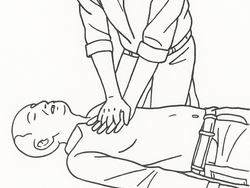

Immediate measures in case of stopped breathing and cardiac function
- Call 112 (if you haven't already)
- Start with 30 extracardiac compressions and 2 breaths (mouth-to-mouth or mouth-to-nose).
Cardiac massage:
- Place the casualty on a hard surface (e.g. ground), only in this position will cardiac massage be effective;
- Kneel by the side of the casualty's head;
- Place one palm on the middle of the chest and then the other palm over it;
- Stretch your arms out and press the chest down to compress the sternum by about 5-6 cm;
- Try to practice rhythmic massage at a rate of at least 100 presses per minute;
- Regularly check the casualty's vital signs.
Respiration:
- Kneel by the side of the casualty's head;
- Gently lift the head back towards the back of the head;
- Place a piece of bandage or a breathing barrier device over the mouth or nose of the the casualty;
- Make 2 mouth-to-mouth or mouth-to-nose breaths, closing the nose or
- mouth;
- Breathe into the casualty so that the chest rises as in normal breathing;
- Each breath should last 1 second;
- After each inspiration, lift your head and take a breath.
WHEN CALLING EMERGENCY NUMBER 112, PROVIDE THE FOLLOWING INFORMATION:
Where is the location of the incident?
On a rural road, you can give your location using the kilometer markers. If you're on a highway, you should also say in which direction you’re traveling.
What has happened?
Try to describe what has occurred (e.g., there is a person on the ground who is unresponsive and has bleeding from the ear).
Who is calling?
Say your name and, if possible, a phone number you can be reached on.
Wait for the emergency operator to end the call first!
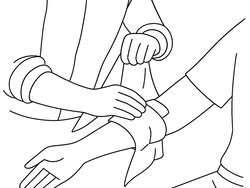
Additional Emergency Measures
Try to protect the injured person from further harm and danger.
Take care of their wounds:
Place the injured person in a sitting or lying position.
Apply sterile gauze and press firmly on heavily bleeding wounds.
Stop the bleeding by applying pressure with your hand or using a pressure bandage.
Relieve the injured person's pain as much as possible and/or place them in the most comfortable position.
Reassure the injured person!
Do not allow thoughtless or incorrect interference from bystanders!
Hand over the injured person to the Emergency Medical Services.